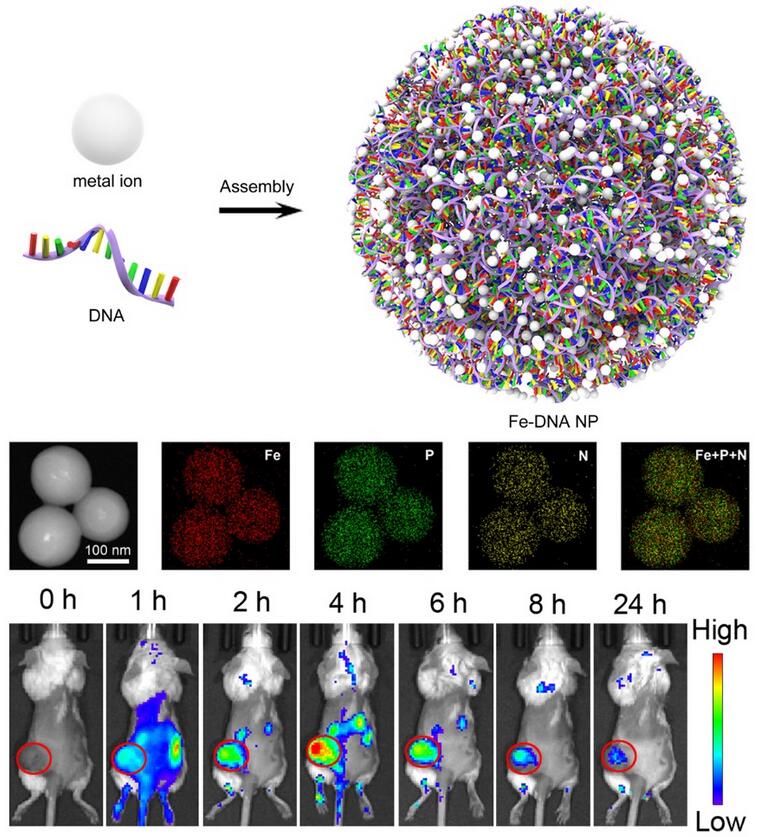Recently, the Li Lele group of the National Nanoscience Center of the Chinese Academy of Sciences has made new progress in the research of DNA nanobiotechnology for nucleic acid delivery. The related research results "Engineering Multifunctional DNA Hybrid Nanospheres through Coordination-Driven Self-Assembly" was published in the Journal of Applied Chemistry in Hot Paper on December 20 (Angew. Chem., Int. Ed. 2018, DOI: 10. 1002/anie.201810735).

As a functional biological macromolecule, DNA has been widely used in analytical chemistry, medical diagnosis, and disease treatment. Since DNA is difficult to cross cell membranes and is susceptible to degradation, how to achieve efficient DNA delivery is a key to the development of this field. Currently, researchers have developed various types of nanocarriers (eg, polymer micelles, liposomes, inorganic nanoparticles) to achieve nucleic acid delivery in vitro and in vivo, but face difficulties in preparation, inefficiency, and poor safety. . In recent years, DNA nanotechnology has developed rapidly and has shown great potential in the delivery of nucleic acids and small molecule drugs. DNA self-assembled nanostructures mainly include: tile self-assembly developed by the Ned Seeman team, DNA origami invented by Dr. Paul Rothemund, and spherical nucleic acids developed by the Chad Mirkin group. However, these methods often require the use of a large number of pre-designed nucleic acid strands of different sequences for assembly or modification and surface functionalization of specific sites of nucleic acids, and such complex synthetic methods hinder their wide application in the biomedical field. Therefore, the development of simple and efficient assembly methods to construct multifunctional DNA nanostructures remains a major problem in the field of DNA nanotechnology.
Inspired by traditional metal-organic coordination chemistry, Li Lele's group first proposed a new concept of constructing DNA nanostructures using metal coordination-driven self-assembly, and invented a new method for self-assembly of synthetic DNA nanostructures. A novel DNA nanomaterial, metal-DNA nanostructure, and indicates that the system can be used for efficient nucleic acid delivery at the cellular and living levels. Importantly, the method is very simple, and it is only necessary to mix the DNA molecule and the metal ion (ferrous ion) in water at a certain temperature to obtain a metal-DNA nanostructure having a spherical morphology in a fast and high yield. Moreover, by adjusting the ratio and concentration of DNA molecules and metal ions, the size and composition of metal-DNA nanostructures can be precisely regulated. Researchers have successfully applied this metal-DNA nanostructure to nucleic acid drug delivery. Studies have shown that as a novel, unsupported nucleic acid delivery system, metal-DNA nanostructures can efficiently deliver nucleic acid drugs to different cells and exert efficient biorecognition and pharmacodynamic effects both in vitro and in vivo. This work demonstrates the potential of metal-coordinated self-assembly in the synthesis of DNA nanomaterials and opens up new methodologies for the construction of DNA nanostructures. Compared to the rapid rise and development of metal-organic framework materials (MOFs), researchers believe that such metal-DNA nanomaterials will greatly advance the development of DNA nanobiotechnology and metal coordination chemistry. In addition, the method will help design multifunctional biomaterials for biosensing, bioimaging, and drug/gene delivery.
This work was previously studied by Li Lele's research group (J. Am. Chem. Soc. 2018. 140, 578-581; J. Am. Chem. Soc. 2017, 139, 13804-13810; Adv. Mater. 2018, 1804745) Based on the implementation. The study was supported by the National Talent Program and the National Natural Science Foundation.
Magnetostrictive System Scaler
A magnetostrictive system scaler is a dental instrument used for removing calculus and plaque from the teeth. It utilizes high-frequency vibrations generated by a magnetostrictive transducer to break down and remove the deposits from the tooth surface.
Magnetostrictive System Scaler,Cavitron Type Scaler,Dentsply Type Scaler,Dental Magneto Scaler
Rolence Enterprise Inc. , https://www.rolencedent.com